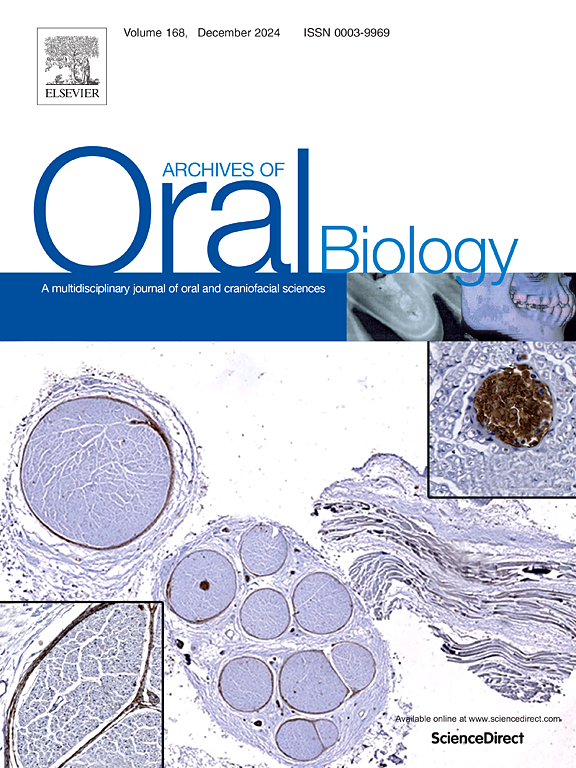细胞外基质蛋白组成与颞下颌关节椎间盘移位的退行性改变相对应
IF 2.1
4区 医学
Q2 DENTISTRY, ORAL SURGERY & MEDICINE
引用次数: 0
摘要
目的探讨颞下颌关节(TMJ)后盘附着区细胞外基质(ECM)蛋白组成的变化与椎间盘移位伴/不复位(DDwR, DDwoR)诊断的关系。设计:因DDwR或DDwoR而计划进行关节镜检查或开放关节手术的患者符合纳入条件。术中对后椎间盘附着物进行活检。从活组织中提取蛋白质,并使用多重头分析筛选23种不同的ECM蛋白。DDwR患者作为DDwoR的对照。用分位数回归模型评估变量性别、年龄、症状持续时间、既往创伤和Wilkes标准与蛋白质浓度的关系。p <; 0.05。结果与DDwR相比,ddwor患者术前开口容量更小(p <; 0.001),症状持续时间更短(p = 0.007)。与迟发性DDwoR相比,突发性DDwoR患者更常将颌骨创伤作为刺激事件(p = 0.014)。调整分析,ADAMTS13 (p = 0.000),aggrecan (p = 0.012),胶原IVα1 (p = 0.001),Lumican (p = 0.008),MMP-7 (p = 0.000),MMP-10 (p = 0.043),NCAM-1 (p = 0.006),Tenascin C (p = 0.030),TIMP-2 (p = 0.000),和TIMP-3 (p = 0.027)在DDwoR浓度显著升高。MMP-9 (p = 0.019)和syndecan-4 (p = 0.002)与女性性别呈正相关。较高的Wilkes标准对应较高的蛋白质组成,类似于DDwoR与DDwR相比蛋白质组成增加的情况。结论ecm蛋白组成随TMJ诊断和Wilkes标准的改变而改变,提示退行性改变是主要因素。性别似乎对ECM影响不大。本文章由计算机程序翻译,如有差异,请以英文原文为准。
Extracellular matrix protein composition corresponds to degenerative changes in disc displacement of the temporomandibular joint
Objective
To investigate changes to the composition of a panel of extracellular matrix (ECM) proteins in the temporomandibular joint (TMJ) posterior disc attachment in relation to the diagnoses disc displacement with/without reduction (DDwR, DDwoR).
Design
Patients scheduled for arthroscopy or open joint surgery due to DDwR or DDwoR were eligible for inclusion. During surgery biopsies of the posterior disc attachment were harvested. Proteins were extracted from the biopsies and screened using multiplex bead analysis for 23 different ECM proteins. Patients with DDwR served as controls to DDwoR. The variables gender, age, symptom duration, previous trauma, and Wilkes criteria were assessed in relation to the protein concentrations with a quantile regression model. Significance was set at p < 0.05.
Results
DDwoR patients had smaller preoperative mouth opening capacity (p < 0.001) and shorter symptom duration (p = 0.007) compared to DDwR. Patients with a sudden onset of DDwoR more often had trauma to the jaws as an inciting event compared to delayed onset DDwoR (p = 0.014). In the adjusted analyses, ADAMTS13 (p = 0.000), aggrecan (p = 0.012), collagen IVα1 (p = 0.001), Lumican (p = 0.008), MMP-7 (p = 0.000), MMP-10 (p = 0.043), NCAM-1 (p = 0.006), Tenascin C (p = 0.030), TIMP-2 (p = 0.000), and TIMP-3 (p = 0.027) had significantly higher concentrations in DDwoR. MMP-9 (p = 0.019) and syndecan-4 (p = 0.002) demonstrated a positive strong correlation to female gender. A higher Wilkes criteria corresponded to a higher protein composition similarly to how protein composition increased in DDwoR compared to DDwR.
Conclusion
ECM protein composition changes with TMJ diagnoses and Wilkes criteria suggesting degenerative changes as a main factor. Gender seems to marginally affect the ECM.
求助全文
通过发布文献求助,成功后即可免费获取论文全文。
去求助
来源期刊

Archives of oral biology
医学-牙科与口腔外科
CiteScore
5.10
自引率
3.30%
发文量
177
审稿时长
26 days
期刊介绍:
Archives of Oral Biology is an international journal which aims to publish papers of the highest scientific quality in the oral and craniofacial sciences. The journal is particularly interested in research which advances knowledge in the mechanisms of craniofacial development and disease, including:
Cell and molecular biology
Molecular genetics
Immunology
Pathogenesis
Cellular microbiology
Embryology
Syndromology
Forensic dentistry
 求助内容:
求助内容: 应助结果提醒方式:
应助结果提醒方式:


